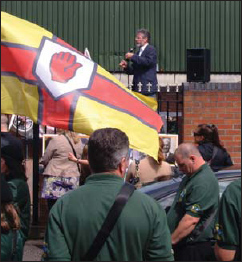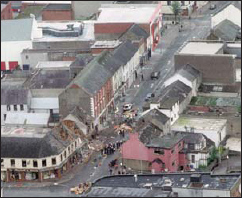
1920 Government of Ireland Act passed, partitioning Ireland into North and South
1922 Formation of the RUC
1939– IRA bombing campaign in England
1940
1941 April–May Belfast ‘Blitz’ by the German Luftwaffe
1956 December IRA launches its border campaign, Operation Harvest
1957 Internment temporarily introduced on both sides of the border
1962 February IRA calls a halt to Operation Harvest and dumps arms
1964 The Revd Ian Paisley leads protest march into Divis Street in the Falls Road area, sparking off three nights of intense rioting
1965 Ulster Volunteer Force (UVF) formed; former soldier ‘Gusty’ Spence appointed as its first commander
1966 50th anniversary of the Easter Rising heightens tensions; UVF murders several people across Belfast
1967 Northern Ireland Civil Rights Association (NICRA) formed
1968 5 October NICRA march turns violent in Duke Street, Derry/Londonderry
1969 4 January People’s Democracy march from Belfast to Derry/Londonderry attacked by Loyalists and Ulster Special Constabulary members (‘B’ Specials) at Burntollet
28 April Northern Ireland’s Prime Minister, Terence O’Neill, resigns from office
10 August Rioting in Belfast and Derry/Londonderry
14 August British troops deploy onto Northern Ireland’s streets
December IRA splits into Official and Provisional wings
1970 April ‘B’ Specials disbanded; Ulster Defence Regiment formed
3–5 July Falls Road Curfew
1971 6 February First British Army soldier, Gunner Robert Curtis, killed by the IRA
9 August Internment reintroduced
1972 30 January Soldiers from 1st Battalion, The Parachute Regiment, open fire on civil rights marchers; 27 people are wounded, 14 fatally. It later becomes known as ‘Bloody Sunday’
July The IRA detonates 22 bombs across Belfast, killing nine people and injuring hundreds on ‘Bloody Friday’; Operation Motorman is launched to retake ‘no-go’ areas
1974 4 February The IRA kills 11 (including two young children) when it blows up a coach carrying off-duty soldiers and their families
May Loyalist strike brings down power-sharing experiment
5 October The IRA carries out the bombings of two Guildford pubs, killing four people
21 November The IRA bombs two Birmingham pubs, killing 19

Sinn Féin President Gerry Adams gives a speech in August 2007 commemorating the actions of Republicans in August 1969. He is addressing followers in Bombay Street, the scene of house burnings and violence in the early days of the Troubles. (Aaron Edwards)
1976 5 January IRA gunmen execute ten Protestant civilians in Kingsmill, South Armagh; another is wounded
November The IRA reorganizes along cellular lines
1977 Overt military lead in security policy is scaled back in favour of ‘police primacy’
1979 30 March Airey Neave MP, former Colditz prison escapee and close confidant of Margaret Thatcher, is assassinated by the Irish National Liberation Army (INLA) when a bomb explodes under his car at the House of Commons
27 August Lord Mountbatten, the Queen’s cousin and former Chief of the Defence Staff, is blown up by the IRA; 18 British Army soldiers are killed by the IRA in a bomb attack near Warrenpoint
1981 5 May Bobby Sands becomes the first IRA hunger striker to die, after 66 days’ fasting. Nine other IRA and INLA prisoners follow suit
1982 6 December INLA bombs the Droppin’ Well pub in Ballykelly, killing 17 people, including
11 off-duty soldiers based in the town
1983 ‘Supergrass’ trials publicly identify leading terrorists
1984 Gerry Adams begins secret dialogue with the British government
1985 15 November The Anglo-Irish Agreement is signed between the British and Irish governments; start of ‘Ulster Says No’ campaign
1987 8 May Elite SAS soldiers kill eight IRA terrorists in Loughgall
8 November The IRA detonates a no-warning bomb next to the war memorial in Enniskillen, killing 11 people and injuring 63
1988 6 March SAS team kills three IRA terrorists in Gibraltar
16 March Michael Stone, of the Ulster Freedom Fighters (UFF), attacks the funerals of the ‘Gibralter Three’
19 March Two off-duty soldiers are abducted and shot dead by the IRA after mistakenly driving into a Republican funeral cortège
1990 24 October The IRA uses human bomb tactic, killing several soldiers
1991 7 February The IRA mortars 10 Downing Street
1992 1 July The Ulster Defence Regiment is amalgamated with The Royal Irish Rangers to form The Royal Irish Regiment
10 August The Ulster Defence Association (UDA), the largest Loyalist paramilitary group, is banned by the British government

This photograph shows the aftermath of the bombing of Omagh in 1998 by the Real IRA, a splinter group. The 500lb no-warning car bomb claimed the lives of 29 people and two unborn children and injured 380. (IWM HU 98383)
1993 23 October Shankill Road bombing by the IRA kills nine civilians
1994 9, 11 & 13 March The IRA mortars Heathrow Airport
31 August The IRA ends its military hostilities
13 October Loyalist paramilitaries announce a ceasefire
1995 Talks between British and Irish government and paramilitary representatives
1996 9 February The IRA detonates a massive bomb in Canary Wharf, London, heralding an end to its ceasefire
30 May Forum Election
15 June The IRA bombs Manchester city centre
July Orange Order parade at Drumcree, County Armagh, leads to widespread civil disturbances in Northern Ireland
7 October The IRA attacks British Army HQ in Lisburn, with two 500lb (227kg) bombs, killing one soldier and injuring 20 other people
1997 12 February Lance Bombardier Stephen Restorick is killed by a sniper; he is the last soldier to die in Operation Banner
20 July The IRA reinstates its ceasefire
1998 10 April The Belfast/Good Friday Agreement is signed
15 August The Real IRA, an ultra-Republican splinter group, explodes a no-warning car bomb in Omagh, County Tyrone, killing 29 people and two unborn children
1999 29 November Power-sharing executive appointed
2 December Direct rule ends; power devolved to Stormont
2000 Loyalist feud between the UDA/UFF and the UVF/RHC (Red Hand Commando, a small paramilitary group with close ties to the UVF)
2001 The ‘Holy Cross dispute’ in Ardoyne, North Belfast, sees British troops once again deployed in a major operation to keep the peace
2002 IRA spy ring uncovered at Stormont, prompting the collapse of the powersharing executive and suspension of devolution
2005 28 July The IRA calls an end to its armed campaign
September Annual Whiterock Orange Order parade in West Belfast ends in the worst rioting in three decades; the IRA decommissions the last of its weapons and explosives
2006 October Multi-party talks lead to the St Andrews Agreement
2007 8 May Devolution returns to Northern Ireland, as Ian Paisley and Gerry Adams agree to enter a powersharing executive
31 July Operation Banner ends